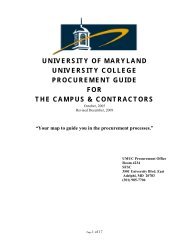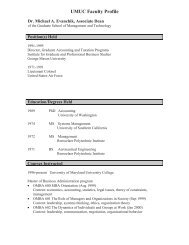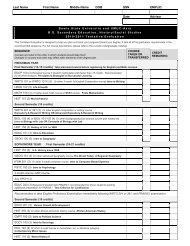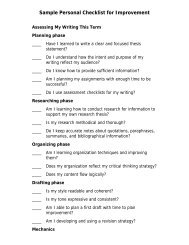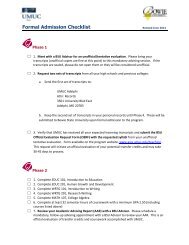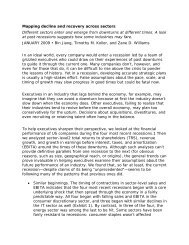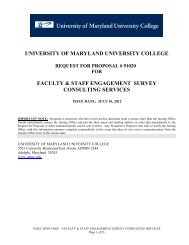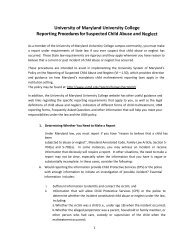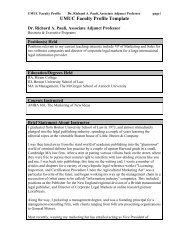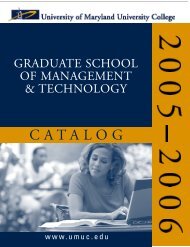A+B. Intro_SJ.1 - University of Maryland University College
A+B. Intro_SJ.1 - University of Maryland University College
A+B. Intro_SJ.1 - University of Maryland University College
Create successful ePaper yourself
Turn your PDF publications into a flip-book with our unique Google optimized e-Paper software.
OMDE 690 Distance Education Portfolio and Project (3)<br />
This required capstone course covers two significant tasks f o r<br />
students: (1) creating a personal distance education portfolio that<br />
will serve as an ongoing pr<strong>of</strong>essional re s o u rc e , as well as a useful<br />
job search tool, and (2) developing and documenting a case<br />
study/project for an organization in the area <strong>of</strong> distance education<br />
and training. The purpose <strong>of</strong> this is to provide the student<br />
with an opportunity to display and practice a variety <strong>of</strong> skills<br />
and knowledge in the area <strong>of</strong> distance education and training.<br />
OMED 600 Foundations <strong>of</strong> Technology in Teaching and<br />
Learning (3)<br />
(Also listed as OMAT 609.) This course builds on the traditional<br />
concepts found in foundations <strong>of</strong> education courses, but incorporates<br />
how technology affects and advances learning. Issues involving<br />
the history and evolution <strong>of</strong> technological innovations<br />
in education, ethics, and the use <strong>of</strong> technology for testing a n d<br />
assessment are addressed. Detailed topic explorations include collaborative,<br />
object-based, and museum learning principles; the<br />
integration <strong>of</strong> technology in the assessment <strong>of</strong> learning styles;<br />
and performance-based and standards-based curricula. Strategies<br />
for using technologies with special needs populations are also<br />
examined.<br />
OMED 610 Digital Information Literacy for K–12<br />
Educators (3)<br />
Prerequisite or corequisite: OMED 600. Expertise is developed<br />
in the use and evaluation <strong>of</strong> a wide array <strong>of</strong> electronic information<br />
resources, including ERIC, LexisNexis, Marco Polo, the<br />
World Wide Web, and numerous subject-specific databases.<br />
Teachers develop a portfolio <strong>of</strong> electronic references for use in<br />
curriculum design. Age- and content-appropriate exercises and<br />
assignments are developed to help build K–12 student information<br />
literacy skills. Teachers acquire a working knowledge <strong>of</strong><br />
information resources in the field <strong>of</strong> education and in specific<br />
content areas to assist them in future curriculum development<br />
and research activities. Criteria to evaluate the usefulness and<br />
validity <strong>of</strong> different types <strong>of</strong> education resources are developed<br />
and critically assessed.<br />
OMED 620 Web-Based Learning and Teaching: Design and<br />
Pedagogy (3)<br />
The theory that informs technology-enabled and Web-based<br />
education is examined, with special attention on best pedagogical<br />
practices. Unique challenges related to original design and/<br />
or adaptation <strong>of</strong> Web courses are explored. Participants acquire<br />
knowledge and develop skills to create individual assignments,<br />
special classes, units, and entire courses that take full advantage<br />
<strong>of</strong> synchronous, asynchronous, and/or multimedia technology.<br />
Special emphasis is placed on creation <strong>of</strong> age-, content-, and<br />
context-appropriate exercises for students in a diverse array <strong>of</strong><br />
classroom situations. Teachers develop criteria and specific evaluation<br />
tools to assess student learning outcomes with different<br />
pedagogical approaches, delivery techniques, core content areas,<br />
and technologies. Teachers also examine and contribute to current<br />
and emerging technology-enabled curricular innovations.<br />
OMED 630 Technology in K–12 Education: Synchronous,<br />
Asynchronous, and Multimedia Technologies (3)<br />
Serving as the technological foundation <strong>of</strong> this program, this<br />
course enables K–12 teachers to employ appropriate technologies<br />
in their classrooms and schools. Teacher-participants critically<br />
assess the capacity <strong>of</strong> a variety <strong>of</strong> technologies designed to<br />
meet specific content, delivery, and learner goals and objectives.<br />
Particular attention is paid to Web-based instruction. Teachers<br />
develop knowledge and skills in the application <strong>of</strong> such real-time<br />
technologies as satellite broadcasting, audio conferencing, video<br />
conferencing, synchronous chats, streaming audio and video,<br />
and in asynchronous technologies such as e-mail and listservers.<br />
OMED 640 Using Technology for Instructional<br />
Improvement (3)<br />
Teachers learn how to use technology to become more effective<br />
in the classroom and more efficient planners. Technologies integral<br />
to curriculum and instruction can also enhance teachers’<br />
day-to-day activities in classroom administration and management.<br />
Topics covered include PowerPoint, database programs,<br />
spreadsheets, electronic gradebooks, desktop publishing, portfolio<br />
development, and various types <strong>of</strong> educational s<strong>of</strong>tware.<br />
Practical applications for the contemporary classroom are<br />
emphasized.<br />
| 142 | 2003–2004 Graduate Catalog




